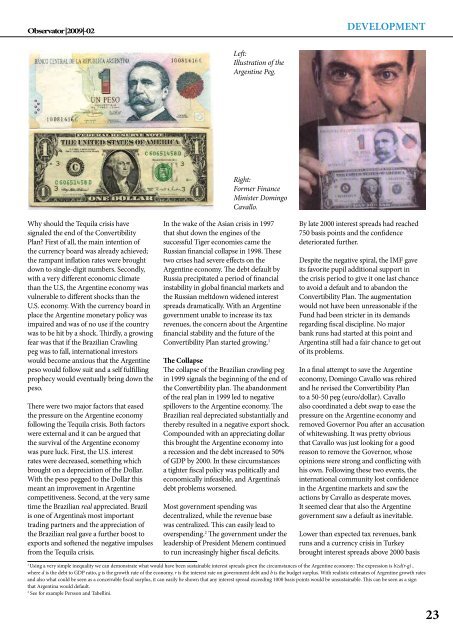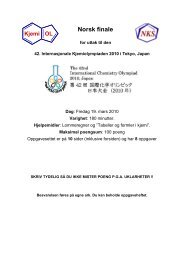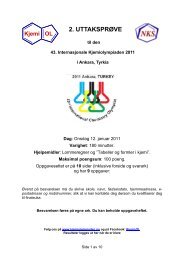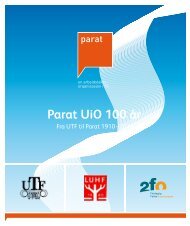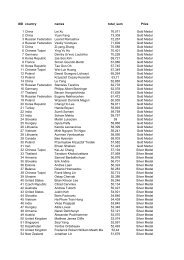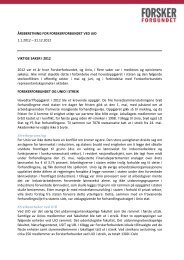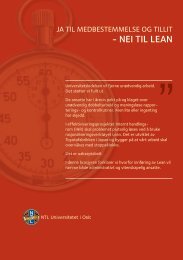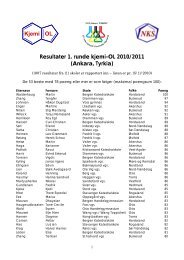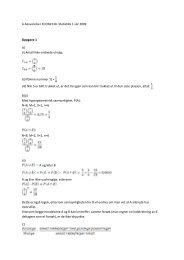2009:2 - Universitetet i Oslo
2009:2 - Universitetet i Oslo
2009:2 - Universitetet i Oslo
- No tags were found...
Create successful ePaper yourself
Turn your PDF publications into a flip-book with our unique Google optimized e-Paper software.
Observator |<strong>2009</strong>|-02DEVELOPMENTLeft:Illustration of theArgentine Peg.Why should the Tequila crisis havesignaled the end of the ConvertibilityPlan? First of all, the main intention ofthe currency board was already achieved;the rampant inflation rates were broughtdown to single-digit numbers. Secondly,with a very different economic climatethan the U.S, the Argentine economy wasvulnerable to different shocks than theU.S. economy. With the currency board inplace the Argentine monetary policy wasimpaired and was of no use if the countrywas to be hit by a shock. Thirdly, a growingfear was that if the Brazilian Crawlingpeg was to fall, international investorswould become anxious that the Argentinepeso would follow suit and a self fulfillingprophecy would eventually bring down thepeso.There were two major factors that easedthe pressure on the Argentine economyfollowing the Tequila crisis. Both factorswere external and it can be argued thatthe survival of the Argentine economywas pure luck. First, the U.S. interestrates were decreased, something whichbrought on a depreciation of the Dollar.With the peso pegged to the Dollar thismeant an improvement in Argentinecompetitiveness. Second, at the very sametime the Brazilian real appreciated. Brazilis one of Argentina’s most importanttrading partners and the appreciation ofthe Brazilian real gave a further boost toexports and softened the negative impulsesfrom the Tequila crisis.Right:Former FinanceMinister DomingoCavallo.In the wake of the Asian crisis in 1997that shut down the engines of thesuccessful Tiger economies came theRussian financial collapse in 1998. Thesetwo crises had severe effects on theArgentine economy. The debt default byRussia precipitated a period of financialinstability in global financial markets andthe Russian meltdown widened interestspreads dramatically. With an Argentinegovernment unable to increase its taxrevenues, the concern about the Argentinefinancial stability and the future of theConvertibility Plan started growing. 1The CollapseThe collapse of the Brazilian crawling pegin 1999 signals the beginning of the end ofthe Convertibility plan. The abandonmentof the real plan in 1999 led to negativespillovers to the Argentine economy. TheBrazilian real depreciated substantially andthereby resulted in a negative export shock.Compounded with an appreciating dollarthis brought the Argentine economy intoa recession and the debt increased to 50%of GDP by 2000. In these circumstancesa tighter fiscal policy was politically andeconomically infeasible, and Argentina’sdebt problems worsened.Most government spending wasdecentralized, while the revenue basewas centralized. This can easily lead tooverspending. 2 The government under theleadership of President Menem continuedto run increasingly higher fiscal deficits.By late 2000 interest spreads had reached750 basis points and the confidencedeteriorated further.Despite the negative spiral, the IMF gaveits favorite pupil additional support inthe crisis period to give it one last chanceto avoid a default and to abandon theConvertibility Plan. The augmentationwould not have been unreasonable if theFund had been stricter in its demandsregarding fiscal discipline. No majorbank runs had started at this point andArgentina still had a fair chance to get outof its problems.In a final attempt to save the Argentineeconomy, Domingo Cavallo was rehiredand he revised the Convertibility Planto a 50-50 peg (euro/dollar). Cavalloalso coordinated a debt swap to ease thepressure on the Argentine economy andremoved Governor Pou after an accusationof whitewashing. It was pretty obviousthat Cavallo was just looking for a goodreason to remove the Governor, whoseopinions were strong and conflicting withhis own. Following these two events, theinternational community lost confidencein the Argentine markets and saw theactions by Cavallo as desperate moves.It seemed clear that also the Argentinegovernment saw a default as inevitable.Lower than expected tax revenues, bankruns and a currency crisis in Turkeybrought interest spreads above 2000 basis1Using a very simple inequality we can demonstrate what would have been sustainable interest spreads given the circumstances of the Argentine economy: The expression is b≥d(r-g) ,where d is the debt to GDP ratio, g is the growth rate of the economy, r is the interest rate on government debt and b is the budget surplus. With realistic estimates of Argentine growth ratesand also what could be seen as a conceivable fiscal surplus, it can easily be shown that any interest spread exceeding 1000 basis points would be unsustainable. This can be seen as a signthat Argentina would default.2See for example Persson and Tabellini.23


